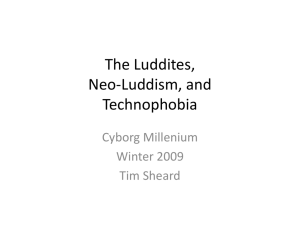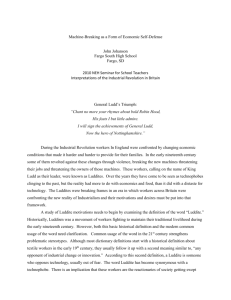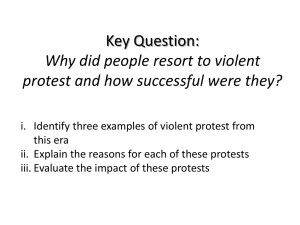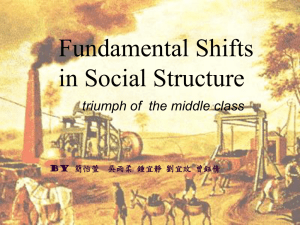The Myth of Ned Ludd: Luddite Uprisings & History
advertisement
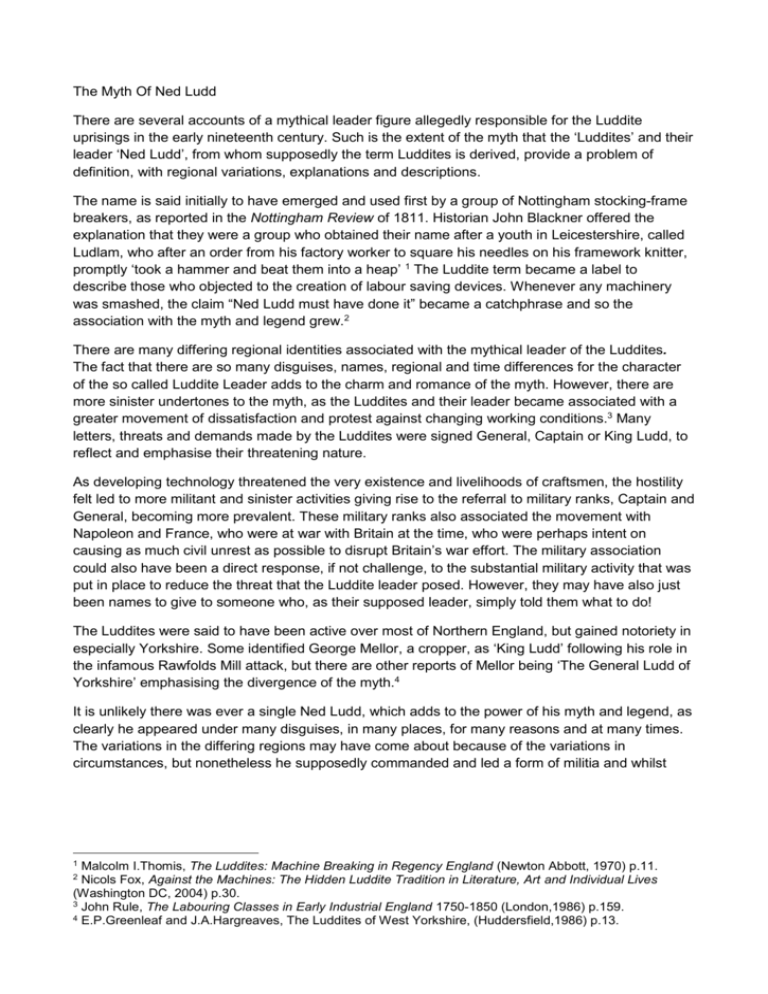
The Myth Of Ned Ludd There are several accounts of a mythical leader figure allegedly responsible for the Luddite uprisings in the early nineteenth century. Such is the extent of the myth that the ‘Luddites’ and their leader ‘Ned Ludd’, from whom supposedly the term Luddites is derived, provide a problem of definition, with regional variations, explanations and descriptions. The name is said initially to have emerged and used first by a group of Nottingham stocking-frame breakers, as reported in the Nottingham Review of 1811. Historian John Blackner offered the explanation that they were a group who obtained their name after a youth in Leicestershire, called Ludlam, who after an order from his factory worker to square his needles on his framework knitter, promptly ‘took a hammer and beat them into a heap’ 1 The Luddite term became a label to describe those who objected to the creation of labour saving devices. Whenever any machinery was smashed, the claim “Ned Ludd must have done it” became a catchphrase and so the association with the myth and legend grew.2 There are many differing regional identities associated with the mythical leader of the Luddites. The fact that there are so many disguises, names, regional and time differences for the character of the so called Luddite Leader adds to the charm and romance of the myth. However, there are more sinister undertones to the myth, as the Luddites and their leader became associated with a greater movement of dissatisfaction and protest against changing working conditions.3 Many letters, threats and demands made by the Luddites were signed General, Captain or King Ludd, to reflect and emphasise their threatening nature. As developing technology threatened the very existence and livelihoods of craftsmen, the hostility felt led to more militant and sinister activities giving rise to the referral to military ranks, Captain and General, becoming more prevalent. These military ranks also associated the movement with Napoleon and France, who were at war with Britain at the time, who were perhaps intent on causing as much civil unrest as possible to disrupt Britain’s war effort. The military association could also have been a direct response, if not challenge, to the substantial military activity that was put in place to reduce the threat that the Luddite leader posed. However, they may have also just been names to give to someone who, as their supposed leader, simply told them what to do! The Luddites were said to have been active over most of Northern England, but gained notoriety in especially Yorkshire. Some identified George Mellor, a cropper, as ‘King Ludd’ following his role in the infamous Rawfolds Mill attack, but there are other reports of Mellor being ‘The General Ludd of Yorkshire’ emphasising the divergence of the myth.4 It is unlikely there was ever a single Ned Ludd, which adds to the power of his myth and legend, as clearly he appeared under many disguises, in many places, for many reasons and at many times. The variations in the differing regions may have come about because of the variations in circumstances, but nonetheless he supposedly commanded and led a form of militia and whilst 1 Malcolm I.Thomis, The Luddites: Machine Breaking in Regency England (Newton Abbott, 1970) p.11. Nicols Fox, Against the Machines: The Hidden Luddite Tradition in Literature, Art and Individual Lives (Washington DC, 2004) p.30. 3 John Rule, The Labouring Classes in Early Industrial England 1750-1850 (London,1986) p.159. 4 E.P.Greenleaf and J.A.Hargreaves, The Luddites of West Yorkshire, (Huddersfield,1986) p.13. 2 men such as Mellor were suspected, no one individual was identified as Ludd and so his identity remained a mystery.5 To highlight the extent to which the term has been associated with social uprising, there are women involved in the 1812 food protests in Leeds reputedly calling themselves ‘General Ludd’s wives’ , with one claiming to be their leader under the name of ‘Lady Ludd’.6 Later, there were associations with leader of the 1830 agricultural Swing Riots in rural England, who protesting over threats to livelihoods and wages.7 The Luddite leader had songs, poems and letters written about him and allegedly by him. He was no doubt the subject of many lively and interesting discussions, conversations and much correspondence throughout the north of England. In Bolton, Lancashire he was known as the grand administrator of impious, rebellious, oaths, and gained further infamy in Yorkshire, Cheshire, Lancashire, Nottinghamshire and Leicestershire.8 The legendary and mythical status attached to him in Yorkshire existed two hundred years ago, which may be largely forgotten but maybe some of him exists in some of us today and it is hoped he will now be brought back to life! FURTHER INFORMATION AND INTRODUCTION / TEACHER WORKSHEET/PUPIL RESOURCES Origins of the myth and legend of Ned Ludd Miles Taylor, ‘Ludd, Ned (fl. 1811–1816)’, Oxford Dictionary of National Biography, Oxford University Press, 2004 [http://www.oxforddnb.com/view/article/40127, accessed 15 Jan 2012 5 6 Malcolm I.Thomis, The Luddites (Newton Abbott, 1970), p.22. Thomis, The Luddites, p.116. 8 Thomis, The Luddites, p.144. 7 In addition to the overview, these pages look at the origins of the myth and legend of Ned Ludd and questions will be asked as to how the myth is/was portrayed and why the myth and legacy of the Luddite leader may have gained its status. These pages can be used in conjunction with the attached Quiz Sheet and Word Search. Ned Ludd, Captain Ludd, King Ludd and General Ludd are all terms associated with the mythical machine breaker and Luddite leader. So what, why and how did the myth come about? Let us try and bring it to life... The early origins are said to have been around Leicestershire and Nottinghamshire. In 1779, a ‘feeble minded’ village boy in Leicestershire by the name of Ned Ludd was tormented and bullied by other boys. One day, after being tormented so much by the other boys that after a while, he became so fed up and he wanted the bullying to stop, so he decided to chase the bullies away. Ned was said to have tried to catch the boys, but, when he was unable to catch them, he became so frustrated that he ran into a house and started to break up some spinning frames.9 (Film clip one is used to illustrate this). (How do you think the village boy Ned Ludd felt? How would you have reacted to the taunting of the bullies? Was it wrong to break up the spinning frames?) In 1811, the historian John Blackner’s History of Nottingham suggested that the Luddites were a group who obtained their name after a youth, again in Leicestershire, called Ludlam, who after an order from his father to square his needles on his framework knitter, promptly ‘took a hammer and beat them into a heap’.10 (Film clip two is used to illustrate this). The mythical figure and name ‘General Ludd’ rose to prominence in association with sporadic outbreaks of machine breaking in Nottinghamshire. 11 Throughout 1811 until 1816, the myth of Ned Ludd along with the activities of Luddites spread throughout much of Northern England. Luddites often signed their proclamations ‘Ned Ludd’ and some gave their address as Sherwood Forest. This played on the myth of Robin Hood, who was another infamous regional character in the Nottingham area. ‘Chant no more your old rhymes about bold Robin Hood, His feats I but little admire, I will sing the Achievements of General Ludd Now the Hero of Nottinghamshire’ (from General Ludd’s Truimph – Luddite Song)12 Why would there need to be an association with Robin Hood? (Leader of men, intent on standing up for themselves against what they saw was bad?) To avoid detection, workers also often dressed up as women in attempt to disguise themselves and avoid identity. They often met in secret at places such as the upstairs rooms in The Shears Inn 9 Douglas Liversidge, ‘The Luddites’, (London, 1972) p.15. Miles Taylor, ‘Ludd, Ned (fl. 1811–1816)’, Oxford Dictionary of National Biography, Oxford University Press, 2004 [http://www.oxforddnb.com/view/article/40127, accessed 15 Jan 2012 11 Extract from Luddite Link Website. 12 Thomis, Luddism in Nottinghamshire (Chicester, 1972) p.1. 10 at Hightown, Yorkshire, when on a Saturday evening some croppers met to discuss their plans.13 (Film Clip 3). Another famous meeting place was the Dumb Steeple in Mirfield.14 Why do you think they would need to disguise themselves? Such was the notoriety of the Luddite leader and the seriousness of the crimes which they supposedly committed that ‘Wanted Posters’ were issued throughout the region. However, as he was allegedly seen and worked under the cover of many disguises, names and places, how possibly were people going to be able to identify him, even though the local magistrates and law leaders offered lots of money to people who could identify him and on numerous occasions the authorities thought they had caught a General, Captain or King, only to find him appearing somewhere else!15 Why did the Luddites think they needed to have a mythical figure? Would the wanted posters help catch the Luddite leader or would they may it more difficult? Explain why.) It is said that the Yorkshire Luddites used hammers, created by Enoch and James Taylor of Marsden, to destroy the machines and so the name Enoch Hammers became associated with the activities of the Luddites and their leader, who used the phrase ‘Enoch hath made them, Enoch shall break them’16 The hammers used in the film clip are like the Enoch Hammers! The Luddites, amongst other things, were said to have being trying to protect their skills, craftsmanship and means of making a living. New machinery was being developed in the early Nineteenth Century as the Industrial Revolution started, which would have meant that jobs done by hand would be replaced by machines and would result in them losing their jobs. They also were concerned that the quality of the cloth they produced would be reduce, so by breaking the new machines they would protect their livelihoods and their trade. This applied in particular in Yorkshire, where croppers used heavy machinery in their homes to smooth the surface of the cut cloth, but was their wages were threatened by developing machinery which could do the same job in a factory environment. ‘They said Ned Ludd was an idiot boy That all he could do was wreck and destroy, and He turned to his workmates and said: Death to Machines They tread on our future and they stamp on our dreams.’ (How you would feel if you had a job that you had pride in and that was your livelihood, became threatened? What impacts do think it would have had?) Although Luddite activity is said to have all but disappeared by 1816, such was the strength of the legend and myth that in 1830 Ludd’s name was revived and became associated with the infamous Captain Swing, who was responsible for the Swing Riots of 1830 in agricultural England, although Swing is said to have supposedly achieved much more and became more famous than his predecessor, General Ludd.17 However, the myth of Ned Ludd remains exactly that and who knows if it could be raised again! 13 Thomis, The Luddites, p.116. Extract from Luddite Link Website. 15 Thomis, The Luddites, p.120. 16 E.P. Greenleaf and J.A.Hargreaves, The Luddites of West Yorkshire, (Huddersfield, 1986), p.13. 17 Thomis, The Luddites, p.12. 14 Bibliography Fox,N., Against the Machines: The Hidden Luddite Tradition in Literature, Art and Individual Lives (Washington DC, 2004). Greenleaf, E.P. and Hargreaves, J.A., The Luddites of West Yorkshire, (Huddersfield, 1986). HBI C E N T E N ARY A M Liversidge,D., The Luddites, (London, 1972). Rule,J., The Labouring Classes in Early Industrial England 1750-1850 (London,1986). Taylor,M., ‘Ludd, Ned (fl. 1811–1816)’, Oxford Dictionary of National Biography, Oxford University Press, 2004 [http://www.oxforddnb.com/view/article/40127, accessed 15 Jan 2012 Thomis, M.I., Luddism in Nottinghamshire (Chicester, 1972). Thomis, M.I., The Luddites: Machine Breaking in Regency England (Newton Abbott, 1970). B H GH DG UE I N RE E R OA DL I G QS A K P S X V E C H S H MM F Y U T DH I Z S Y G N U U I W S O E A E R DW L B U T DE DN B O V C E H MA R S GO RT NT K I UN DG V H OA V M C H I N L O J H DH NG CP AO P J TS AI I N NL OMG R B W K L L S U T HDE I DK R I X E T U B E F E HJ MI C Luddite Wordsearch Luddite Quiz 1. What are the two versions of how the name Ned Ludd came about? 2. Name the two types of machine mentioned in the text that were broken in the two film clips? 3. What was the year when the myth of Ned Ludd is said to have begun? 4. Name two counties where the early attacks have said to have taken place? 5. Who was the other mythical figure associated with Ned Ludd and where was he supposed to have lived? 6. Why did he disguise himself as a woman? 7. Going back to the film clip, what was the name of the pub where the man was disguised as a woman in order to fool people of who Ned Ludd really was? 8. What was the name of the hammer used to break the machines? 9. How many different disguises did Ned Ludd have? Bonus Question for an extra point, can you name them? 10, What were the Luddites protesting against?
